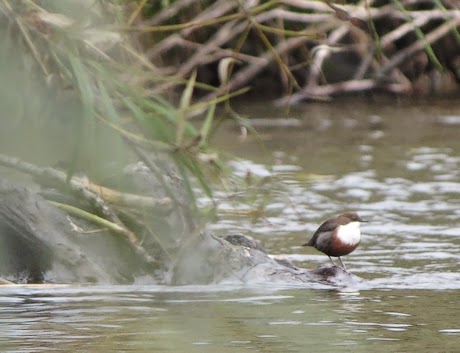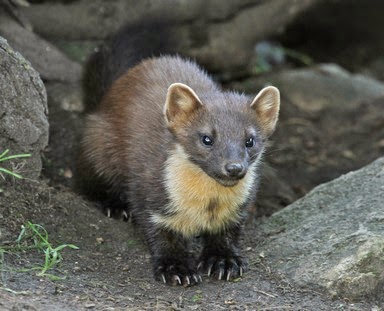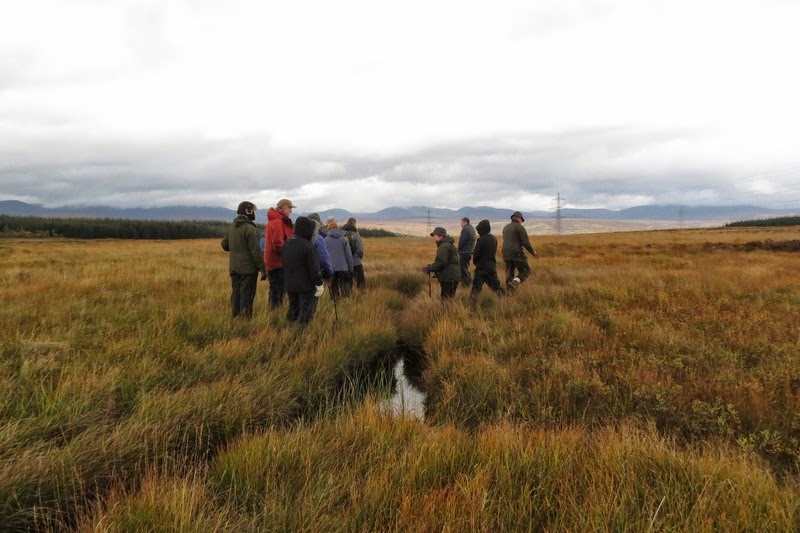 |
| Kindrogan |
Recently five members of our local group
attended the Small mammal course with Jeff Clark at the Kindrogan field studies
centre in Scotland.
It was a short break with a full itinerary,
unfortunately no one told the great weather controller in the heavens and heavy
rain played havoc with our last day.
An early start after a scrumptious
breakfast (and yes I did have porridge, although I didn’t have it with salt
like Jeff!) saw the Kindrogan 12 familiarizing ourselves with putting together
the Longworth mammal traps and loosely packing them with rabbit mix and hay for
protection and warmth, note - add broken chocolate biscuit – a vole and mouse
favourite, and lots of casters (pupae of blue bottles) for the ever hungry shrews. We then placed
them in different areas in the Kindrogan estate grounds, alongside a walled
garden, a wooded area, and a riverside/field boundary. We would return later
that day to see who’d been visiting.
 |
| Trap team |
 |
| Longworth trap |
 |
| Instruction |
We then spent the rest of the day visiting
our stake out areas.
 |
| Mallard prep |
We had hoped to catch a glimpse of a
wildcat, a long shot we know, but to this end Jeff had acquired an
unfortunate road kill Mallard, which we
utilised by hanging it up in a tree beside the nearby River Ardle, Jeff then
fixed a trail camera alongside hoping to catch any visitors.
Similarly a chance to see wild beavers saw
us driving to another area by the River
Ericht , here we hoped to do an evening beaver watch on our last evening.
A generous helping of apples and more trail
cameras left on watch. A glimpse of a dipper was a bonus.
 |
| Dipper |
(prev footage)
A walk up the trail behind the lodge
leading to the old estate burial grounds gave us fabulous views of the Scottish
countryside, no sign of wild cats sadly.
A quick visit back to the traps before tea,
revealed a few traps had gone off by the walled area and Jeff demonstrated how
to empty and handle the mammals safely, voles being the usual suspects. Traps
re-stocked and re-set we left them over night.
After dinner we all retreated to the
comfort of the minibuses which had been positioned by the Pine martin logpile
feeding station. Logpile stocked with peanuts we waited,
 |
| Spot - Jeff clarke |
regular diners were named spot, smudge and
squinty. Infrahead light bathed the log pile and eventually one came out, 2 red
eyes shining out (not squinty then - our one eyed martin) enchanting, what
beautiful animals they are.
The experience certainly touched us, Peaty
Jen wrote
'As the mist spread languidly across the fields, a deer barked
in the distance and a tawny owl pronounced its presence nearby. We hardy souls
clad in suitably layered clothing sat in a minibus in the dark with all the
windows open. After barely 10 minutes we then saw our quarry and spent the next
15 minutes beguiled and entranced watching a pine marten feeding’
Next day, our first job was back to the
traps and lots of opportunities for those who wished to? a lesson in small
mammal handling. ’ No one was compulsed to handle the critters...
 |
| Kev and shrew |
 |
| Linda |
Bank and field voles, hyperactive common
shrews, feisty wood/field mice and an unexpected house mouse dropped out of our
traps!
MMmh handling, the ever patient Jeff over saw proceeding, a bit of confidence,
relax, straighten up and for gods sake
remember to breathe is the key…thanks Jeff. And on that note, then practice, practice.
 |
| Jeff and vole |
Focus on the perfect thumb and finger positioning and gathering of skin behind
the little un's head, thus avoiding discomfort and minimizing the ability of
the mammal to turn its head and giving you a nip!
On a personal note I was determined to give
it ago, and I found it easier to tackle when physically I was not feeling tired
and cold (no good with cold stiff hands) so the morning sessions felt better. Although
I'm not sure when I'm likely to use the skill again, It's an experience I’m not
likely to forget.
 |
| Laura and house mouse |
Observing the animals at close quarters is a treat, the shrew who never stopped run around the tank, no wonder they have to eat there own body weight in food. The endearing vole washing his face and the juveniles in moult with their two toned coats.
After dinner we took to the road to drive
to the upland water vole habitat, along the way we observed deer on the
hillsides, red, roe and fallow seen in the area. After a trudge over the bog, I
wore wellies the entire trip! Jeff identified a likely area for a colony
alongside a stream.
 |
| Upland Bog |
Water voles feed on waterside grasses, sedges and rushes and live
in colonies using burrows dug into the side of the watercourses.
 |
| Vole tunnels |
 Jeff pointed out their entrance holes, noticeably larger than
field voles and in some areas you could
make out nibbled areas of vegetation, the voles grazed ‘lawns’.
Jeff pointed out their entrance holes, noticeably larger than
field voles and in some areas you could
make out nibbled areas of vegetation, the voles grazed ‘lawns’.
There were also droppings,
larger, cylindrical with blunt ends near the burrow entrances. We positioned ourselves along the water
course and sat quietly for roughly 40minutes, alas ‘ratty’ wasn't coming out to
play.
 |
| Oak egger |
On the bog we did find
several oak
egger moth caterpillars and spooked red grouse.
Back to the centre
another session with the mammal traps and a survey of our findings for Jeff -species,
approx age and sex. Most of the traps had gone off and it took us quite while
to get round.
The planned evening
entertainment was bat detecting, however despite having various
recorders we failed to pick any up, over the weekend the temperature had
dropped and the bats, pipistrelle, soprano pipistrelle and daubenton's, sensible I guess decided to stay in their
roosts, it was flipping freezing!
During the night it began to rain, in the
morning it was still raining, we woke up to a flood, the road to Pitlochry was
closed and the day before’s serene River Ardle had turned into a torrent and
burst it banks, fortunately for us and more importantly the mammals we had been
trapping by the riverside, we had taken in the traps the night before, all was
now under water.
 |
| classroom |
The weather being inclement meant we spent
the morning dissecting bird pellets. Unable
to find any owl pellets on site, Jeff had provided us with a big bag of kestrel
pellets. Placed in a little water and using tweezers to gently tease them apart,
we revealed what the little raptor had been eating.
Kevin had the pick of the pellets and
uncovered a small mammal jaw bone, others had identifiable field vole teeth,
others rib, leg and pelvic bones. http://www.rspb.org.uk/Images/Owlpellets_tcm9-133500.pdf
The rain eased a little and we headed out,
fog hung in the air. On arrival at the River Ardle we soon discovered the
waters had taken our mallard, such was the height of the waters; fortunately Jeff’s
camera was an inch above the water and was retrieved.
 |
| Before |
 |
| River Ardle in flood |
However the flood was not
a good sign and we soon realised our chances off doing a beaver watch were zero,
as the river Ericht was likely to be
raging as well, and Jeff and John’s cameras were likely to be underwater or
downstream.
We moved on the Glenshee valley, along the
way large areas were underwater; three sheep were observed marooned on an tiny
grassy island, surrounded by water (a couple of hrs later we caught up with
them again, the water had receded a little and they looked a little less
desperate) Arriving at the ski lift/café we got good views of red grouse, and a
mountain hare was espied.
 |
| Red deer |
More red deer including a superb stag on the ridge of
a hillside, a kestrel and a couple of buzzards entertained us for a while in
the valley.
 |
| Loch straloch |
Before dinner we took a stroll around the
old lodge & loch Straloch, an old haunt of Queen Victoria and a good place
to see otters, however time was not on our side and chef insisted we were back
for seven so we couldn’t wait any longer to see tarka! However this late evening
trip did give us the most spectacular weather created vista of a double rainbow
and a moonlit valley.
 |
| Double rainbow |
Beaver watch cancelled another opportunity
to watch the Kindrogan pine martins, this time the kits stole the show, 2 of
this years young came out together and stole our hearts with their antics.
Here’s peaty Jen’s parting facebook comment
So you all liked my pine marten yesterday. Now
wait for it: tonight we saw TWO and we think they are twins. How fab is that?
Just one of today's wonderful experiences which included seeing rather
spectacular flooding, my first visit to the Cairngorm National Park, good
sightings of brown and mountain hares and red and roe deer, a magnificent
double rainbow and the most enchanting moon rise. Such is the magic of doing
courses with Jeff Clarke
 |
| Short tailed or Field vole |
So there we have it , quite an experience
Laura

















_Jude_Lane_low_res.jpg)
























